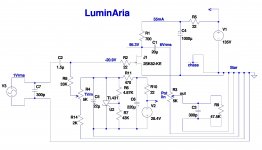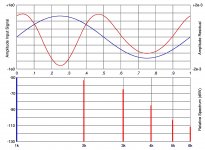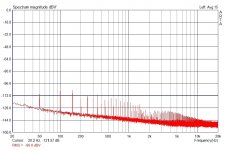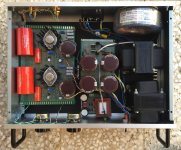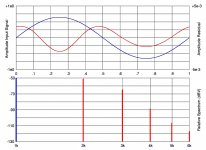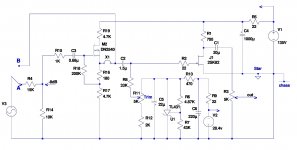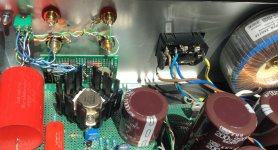Thank you Mike! As a novice, I am very grateful for your assistance and contributions to this forum. It has allowed a non-EE person like me to make wonderful audio equipment!
No problem. The only drawback to an SRPP is that it would require 2 SK79's per channel. Though, I'm sure it could be probably be done with a regular ol' Toshiba on top. 🙂
With the speed of bradypus tridactylus ( it is the slowest mammal on earth ) i finaly finisched the my Luminaria. There is no buffer and the potentiometer at input. The spectrum looks at 1Vrms output with 1Vrms at input. The output noise is with the potentiometer at the maximum.
Attachments
Hi,thank you for your compliments. More information on my Luminaria. Perhaps it could also be called a SIT1 preamp. The power supply is C-L-C-L-CC. The two inductance are 10H-200mA. The Vg is povered by a second transformer. The toroidal transformer is made in Italy. In series with the three Panasonic resistances there is a fourth resistances, different for two channels. A VFET had a greater distortion. Plying with the load resistance and with Vg, the two channels have a similar THD. With Diana it was fun to reach a nice residue ( 2H negative ). The first photo is the THD of second VFETT, the second photo is my listening sistem.
Attachments
The ugly box houses a splendid Sony VFET Part 2. It hosted an Aleph J. It was only just sufficient to dispose of the heat produced
Planing to build a luminaria with a pair of 2SJ60 vfet with a choke load , what would be the inductance needed for fullrange ? 20H at 100ma? For the
2SJ60 biased at 100v 80ma ?
2SJ60 biased at 100v 80ma ?
Thanks zm , always there for the fools 🙂
So with 20H at 5hz will give 625R of reactance
Pretty good!
Also max vds for the 2dk60 is 170v against 240v for the bigger 2dk82
So reducing a little the Vds should be better.
The advantage of this smaller Vfet here should be the refuced input capacitance
So no needs for an input buffer ..
So with 20H at 5hz will give 625R of reactance
Pretty good!
Also max vds for the 2dk60 is 170v against 240v for the bigger 2dk82
So reducing a little the Vds should be better.
The advantage of this smaller Vfet here should be the refuced input capacitance
So no needs for an input buffer ..
Last edited:
I made some changes to Luminaria to lower the THD. Now there is fixed attenuator of about 8 dB at the input. The Buffer can be bypased and therefore there is all the tension to drive a small Power Follower that sooner or later I will build. But also to check if there is any difference in listening.
The pre is now more like Michael Rothacher's project. Since there is no space, the input volume adjustament and the second output from the Buffer are missing.
The THD without Buffer and input attenuation is in post #225. The input voltage is alwayes 1 Vrms.
The pre is now more like Michael Rothacher's project. Since there is no space, the input volume adjustament and the second output from the Buffer are missing.
The THD without Buffer and input attenuation is in post #225. The input voltage is alwayes 1 Vrms.
Attachments
every unnecessary attenuation of signal is sacrilege
if you don't need gain, fix it in different way - decreasing gain of stage itself ...... that way you're altering transfer function , not killing signal energy
if you must shift signal level down , do it with xformer 🙂
if you don't need gain, fix it in different way - decreasing gain of stage itself ...... that way you're altering transfer function , not killing signal energy
if you must shift signal level down , do it with xformer 🙂
Agree with ZM. I would try transformer. With 600: 150 (600:600 quadfilar), the gain and impedance is half, so it effectively works as attenuator + follower, plus elimination of input capacitor. Transformer warms up low frequency a bit like a tube amp, and I like it, but you may not like it, though...
Last edited:
- Home
- Amplifiers
- Pass Labs
- Luminaria?
